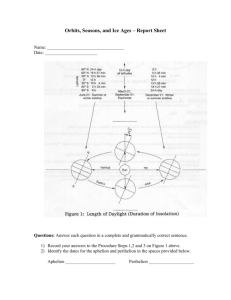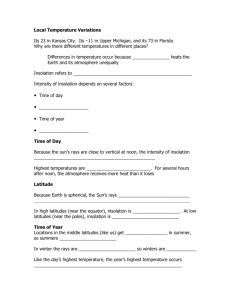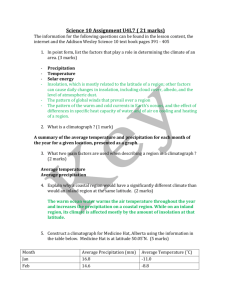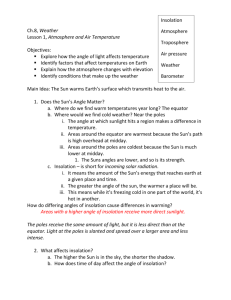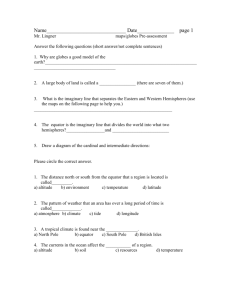a) As the year progresses does the sun`s path change?
advertisement
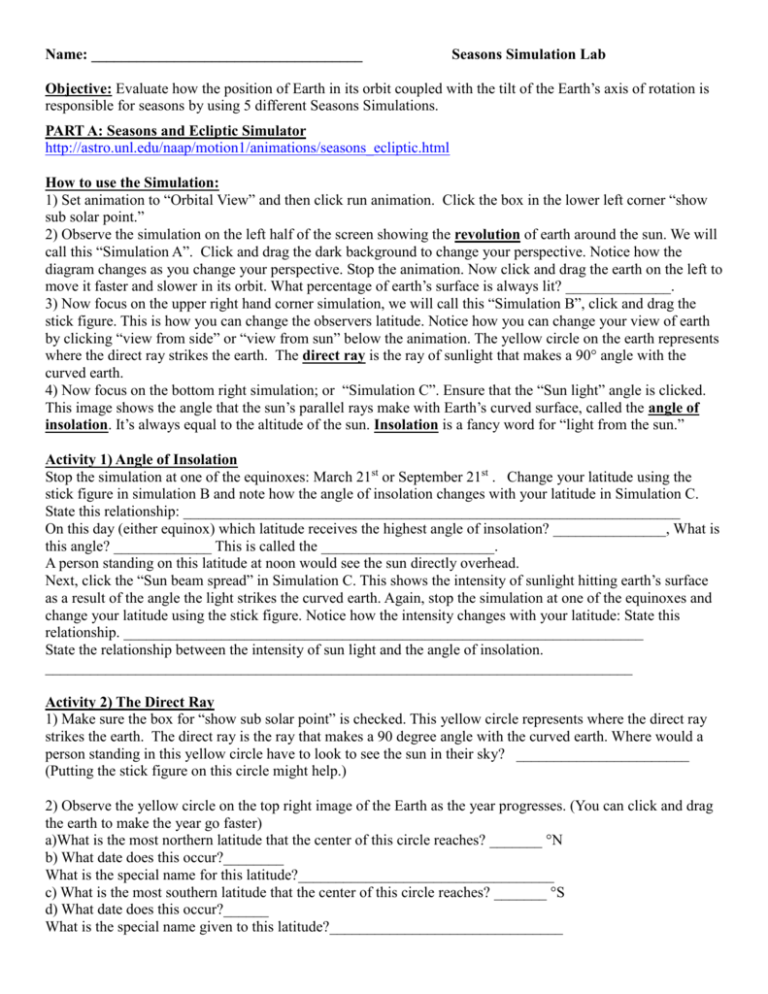
Name: ____________________________________ Seasons Simulation Lab Objective: Evaluate how the position of Earth in its orbit coupled with the tilt of the Earth’s axis of rotation is responsible for seasons by using 5 different Seasons Simulations. PART A: Seasons and Ecliptic Simulator http://astro.unl.edu/naap/motion1/animations/seasons_ecliptic.html How to use the Simulation: 1) Set animation to “Orbital View” and then click run animation. Click the box in the lower left corner “show sub solar point.” 2) Observe the simulation on the left half of the screen showing the revolution of earth around the sun. We will call this “Simulation A”. Click and drag the dark background to change your perspective. Notice how the diagram changes as you change your perspective. Stop the animation. Now click and drag the earth on the left to move it faster and slower in its orbit. What percentage of earth’s surface is always lit? ______________. 3) Now focus on the upper right hand corner simulation, we will call this “Simulation B”, click and drag the stick figure. This is how you can change the observers latitude. Notice how you can change your view of earth by clicking “view from side” or “view from sun” below the animation. The yellow circle on the earth represents where the direct ray strikes the earth. The direct ray is the ray of sunlight that makes a 90° angle with the curved earth. 4) Now focus on the bottom right simulation; or “Simulation C”. Ensure that the “Sun light” angle is clicked. This image shows the angle that the sun’s parallel rays make with Earth’s curved surface, called the angle of insolation. It’s always equal to the altitude of the sun. Insolation is a fancy word for “light from the sun.” Activity 1) Angle of Insolation Stop the simulation at one of the equinoxes: March 21st or September 21st . Change your latitude using the stick figure in simulation B and note how the angle of insolation changes with your latitude in Simulation C. State this relationship: __________________________________________________________________ On this day (either equinox) which latitude receives the highest angle of insolation? _______________, What is this angle? _____________ This is called the _______________________. A person standing on this latitude at noon would see the sun directly overhead. Next, click the “Sun beam spread” in Simulation C. This shows the intensity of sunlight hitting earth’s surface as a result of the angle the light strikes the curved earth. Again, stop the simulation at one of the equinoxes and change your latitude using the stick figure. Notice how the intensity changes with your latitude: State this relationship. _____________________________________________________________________ State the relationship between the intensity of sun light and the angle of insolation. ______________________________________________________________________________ Activity 2) The Direct Ray 1) Make sure the box for “show sub solar point” is checked. This yellow circle represents where the direct ray strikes the earth. The direct ray is the ray that makes a 90 degree angle with the curved earth. Where would a person standing in this yellow circle have to look to see the sun in their sky? _______________________ (Putting the stick figure on this circle might help.) 2) Observe the yellow circle on the top right image of the Earth as the year progresses. (You can click and drag the earth to make the year go faster) a)What is the most northern latitude that the center of this circle reaches? _______ °N b) What date does this occur?________ What is the special name for this latitude?__________________________________ c) What is the most southern latitude that the center of this circle reaches? _______ °S d) What date does this occur?______ What is the special name given to this latitude?_______________________________ Activity 3) Changing your Perspective A) Set the date to the Summer Solstice, June 21st. Click and drag the black background to change your perspective and complete the following diagrams. While Looking Down at the North Pole, Draw the following: -Place a dot on the earth and label it NP for North Pole -Shade the area of earth that is in darkness. -Place arrows on the orbit to indicate the direction of revolution -Draw the equator in red, the tropic of cancer in yellow and the Arctic Circle in blue While Looking at the side view of earth with earth to the right of the sun, Draw the following: -Correctly draw a line for the axis of rotation -Shade the area of earth that is in darkness. -Draw in the direct ray -Draw the equator in red, the tropics in yellow and the arctic circles in blue While Looking at the side view of earth with earth to the left of the sun, Draw the following: -Correctly draw a line for the axis of rotation -Shade the area of earth that is in darkness. -Draw in the direct ray -Draw the equator in red, the tropics in yellow and the arctic circles in blue What latitude is receiving the direct ray on Summer Solstice, June 21st? _____________________________ What is the sun’s altitude (at Noon) for a person in NY (latitude= 42°N) on this day?_______________________ B) Set the date to the Winter Solstice, December 21st. Click and drag the black background to change your perspective and complete the following diagrams. While Looking Down at the North Pole, Draw the following: -Place a dot on the earth and label it NP for North Pole -Shade the area of earth that is in darkness. -Place arrows on the orbit to indicate the direction of revolution -Draw the equator in red, the tropic of cancer in yellow and the Arctic Circle in blue While Looking at the side view of earth with earth to the right of the sun, Draw the following: - Correctly draw a line for the axis of rotation - Shade the area of earth that is in darkness. - Draw in the direct ray - Draw the equator in red, the tropics in yellow and the arctic circles in blue While Looking at the side view of earth with earth to the left of the sun, Draw the following: - Correctly draw a line for the axis of rotation - Shade the area of earth that is in darkness. - Draw in the direct ray - Draw the equator in red, the tropics in yellow and the arctic circles in blue What latitude is receiving the direct ray on this Winter Solstice, December 21st. ______________________ What is the sun’s altitude (at Noon) for a person in NY (latitude= 42°N) on this day?_______________________ C) Set the date to the Fall Equinox September 21st. Click and drag the black background to change your perspective and complete the following diagrams. While Looking Down at the North Pole, Draw the following: - Place a dot on the earth and label it NP for North Pole - Shade the area of earth that is in darkness. - Place arrows on the orbit to indicate the direction of revolution - Draw the equator in red, the tropic of cancer in yellow and the Arctic Circle in blue - While Looking at the side view of earth with earth to the right of the sun, Draw the following: - Draw a dot a label it SP for South Pole. - Shade the area of earth that is in darkness. - Draw in the direct ray - Draw the equator in red, the tropics in yellow and the arctic circles in blue While Looking at the side view of earth with earth to the left of the sun, Draw the following: - Draw a dot a label it NP for North Pole. - Shade the area of earth that is in darkness. - Draw in the direct ray - Draw the equator in red, the tropics in yellow and the arctic circles in blue What latitude is receiving the direct ray on this day?________________________________________ What is the sun’s altitude (at Noon) for a person in NY (latitude= 42°N) on this day?_________________________________ PART B: Reason for the Seasons http://highered.mheducation.com/sites/007299181x/student_view0/chapter2/seasons_interactive.html Click and read the "How To" tab. Next use the "Interactive" tab to complete the activities and questions. 1) Set the inclination angle to 0°. This simulates what you would observe throughout the year if the earth was not tilted. Click on the top box and trace the sun’s path by dragging the planet along its orbit: a) As the year progresses does the sun’s path change? ___________________ b) When does the sun rise each day?_________ When does it set?__________ c) What is the length of day? _______________ Does this value vary throughout the year?_______ d) Observe the angle of insolation, does this change throughout the year? ___________ e) Observe the temperature scale what does it read as the year progresses?________________ f) Would we have seasonal temperature changes if the earth was not tilted? ____________ g) Complete this phrase: “If the earth was tilted less than 23.5°, New York summers would be _______________ in temperature and NY winters would be ___________ in temperature” 2) Set the inclination angle to 23°. This simulates the sun’s path and angle of insolation throughout the year due to the earth’s 23.5° tilt on it’s axis. Click the box “clear trace”. Click and drag the planet along its orbit: a) As the year progresses does the sun’s path change? ___________________ Explain how the path of the sun changes throughout the year: ______________________________________ ______________________________________________________________________________________ b) Observe when the sun rises and sets each day by clicking and dragging the earth along its orbit. Does the sun rise and set the same time each day? _________________ c) Describe how the length of day changes throughout the year:______________________________________ ______________________________________________________________________________________ d) Observe the angle of insolation, does this change throughout the year? ___________ Describe how the angle of insolation changes throughout the year: _____________________________________________________ ______________________________________________________________________________________ e) Observe the temperature scale, describe how the temperature changes throughout the year: __________________________________________________________________________________________ __________________________________________________________________________________ 3) Set the inclination angle to 76°. This simulates what you would observe throughout the year if the earth was extremely tilted on it’s axis. Click the box “clear trace”. Click and drag the planet along its orbit to answer the following questions: a) As the year progresses does the sun’s path change? ___________________ Explain how the path of the sun changes throughout the year?______________________________________ _____________________________________________________________________________________ b) Observe when the sun rises and sets each day by clicking and dragging the earth along its orbit. Doe the sun rise and set the same time each day? _________________ Is the sun visible every day throughout the year? _____ c) Describe how the length of day changes throughout the year:______________________________________ ______________________________________________________________________________________ d) Observe the angle of insolation, does this change throughout the year? ___________ Describe how the angle of insolation changes throughout the year:__________________________________________________ ______________________________________________________________________________________ e) Observe the temperature scale. Describe how the temperature changes throughout the year: __________________________________________________________________________________________ __________________________________________________________________________________ f) Complete this phrase: “If the earth was tilted more than 23.5°, New York summers would be _______________ in temperature and NY winters would be ___________ in temperature.” PART C: Seasonal view of Earth looking down at the North Pole http://science.sbcc.edu/physics/flash/LengthofDay.swf Stop the animation on the dates listed below and shade the diagram to represent the portion of earth that is in darkness looking down at the North Pole. Also sketch in the Arctic Circle (Dotted line on simulation). Place an “x” outside each earth to show the direction the sun rays are coming from. Draw in the line of longitude that is experiencing solar noon. 1) March 21st 2) September 21st 3) June 21st 4) December 21st Questions: 1) Why does every location on earth receive 12 hours of daylight and 12 hours of darkness on the equinoxes?_________________________________________________________________________________ __________________________________________________________________________________________ _______________________________________________________________________________ 2) Why is the Arctic Circle a significant latitude? __________________________________________________________________________________________ __________________________________________________________________________________________ ______________________________________________________________________________ PART D: Seasonal Sun’s Path http://www.eram.k12.ny.us/education/components/docmgr/default.php?sectiondetailid=17500&fileitem=4 941&catfilter=451 Part 1 Directions: Scroll down so that the applet is completely visible. Before beginning the animation, make sure that only the two following boxes are checked: 1) Show the sun’s declination circle & 2) Show stick figure and shadow. All other boxes remain unchecked. The latitude is already set for 40.8 North (West Orange). Start the animation on continuous mode and set the speed to about 100 mins/sec and answer these questions: 1) Observe the stick figure’s shadow throughout the day, when is the shadow the a) longest? B) Shortest? ____________________________________________________________________________________ 2) What is the relationship between the altitude of the noon sun and the length of the shadow? ____________________________________________________________________________________ 3) Why does shadow never fall to the south? _____________________________________________________________________________________ 4) Toward which general direction does sun rise each day? _______________ 5) Toward which general direction does sun set each day? _______________ 6) Toward which direction should an observer at this location look to seen the Noon-time sun? _____________ Now adjust the animation to step by day mode and use the clock to set the time to NOON (12PM). 1) Observe the stick figures shadow throughout the year, during which month is the shadow the longest? ____________________________________________________________________________________ 2) When is the shadow the shortest? ________________________________________________________ 3) Toward which direction does the shadow always fall at noon? _____________________________________________________________________________________ 4) How does the length of the sun’s path change throughout the year? What is the relationship between the length of the sun’s path and the number of daylight hours (duration of insolation)? __________________________________________________________________________________________ __________________________________________________________________________________________ ______________________________________________________________________________ 5) How does the sun’s noon time altitude change throughout the year? When is it the highest in the sky, when is it the lowest? __________________________________________________________________________________________ __________________________________________________________________________________________ ______________________________________________________________________________ 6) Is the sun ever directly overhead, at the observers zenith, at this latitude? ______________________________________________________________________________ Part 2 Directions: Stop the animation. Use the line that runs across the map on the right to adjust your latitude for each of the following cities. Adjust the date using the monthly time line in order to sketch for sun’s path for the equinoxes and solstices for each location. Draw the equinox path in yellow, the summer solstice path in red and the winter solstice path in blue on each diagram. Use the information below the animation to fill in the sun’s noon time altitude. Enter the hours of daylight by subtracting the sunrise time from the sunset time for each date. Label S, E & W on each diagram, N has been completed for you. Click and drag the celestial sphere so that it is oriented with North on the right as depicted in the diagrams below. *Note how this is opposite from the sun path lab we completed, which had North on the left. 1. Tropic of Cancer 23.5° N Date 2. Tropic of Capricorn 23.5° S Sun’s Altitude Hours of Daylight Date 3/21 6/21 N 9/21 12/21 Hours of Daylight Sun’s Altitude Hours of Daylight Sun’s Altitude Hours of Daylight Sun’s Altitude Hours of Daylight 3/21 6/21 N 9/21 12/21 3. Arctic Circle 66.5° N Date Sun’s Altitude 4. Antarctic Circle 66.5° S Sun’s Altitude Hours of Daylight Date 3/21 6/21 9/21 N 12/21 3/21 6/21 N 9/21 12/21 5. North Pole 90° N 6. South Pole 90° S Date Sun’s Altitude Hours of Daylight Date 3/21 6/21 N 9/21 12/21 3/21 6/21 N 9/21 12/21 7. Port Washington 41.5 ° N Date 3/21 6/21 9/21 N 12/21 8. Equator 0° Sun’s Altitude Hours of Daylight Date 3/21 6/21 9/21 N 12/21 Questions: 1. In what direction do people in the northern hemisphere look to see the sun at noon? __________________________________________________________________________________ 2. In what direction do people in the southern hemisphere look to see the sun at noon? __________________________________________________________________________________ PART E: DURATION OF INSOLATION http://www.timeanddate.com/worldclock/sunearth.html Use the link to complete the diagrams below. Shade in the area of darkness as directed for each date. Shade the area of darkness on Dec. 21 @ 12PM Duration of insolation at North Pole _________________________ Duration of insolation at Equator __________________________ Duration of insolation at South Pole ___________________ Shade the area of darkness on March 21 @ 12PM Duration of insolation at North Pole _________________________ Duration of insolation at Equator __________________________ Duration of insolation at South Pole ___________________ Shade the area of darkness on June 21 @ 12PM Duration of insolation at North Pole _________________________ Duration of insolation at Equator __________________________ Duration of insolation at South Pole ___________________ Shade the area of darkness on September 23 @ 12PM Duration of insolation at North Pole _________________________ Duration of insolation at Equator __________________________ Duration of insolation at South Pole ___________________

